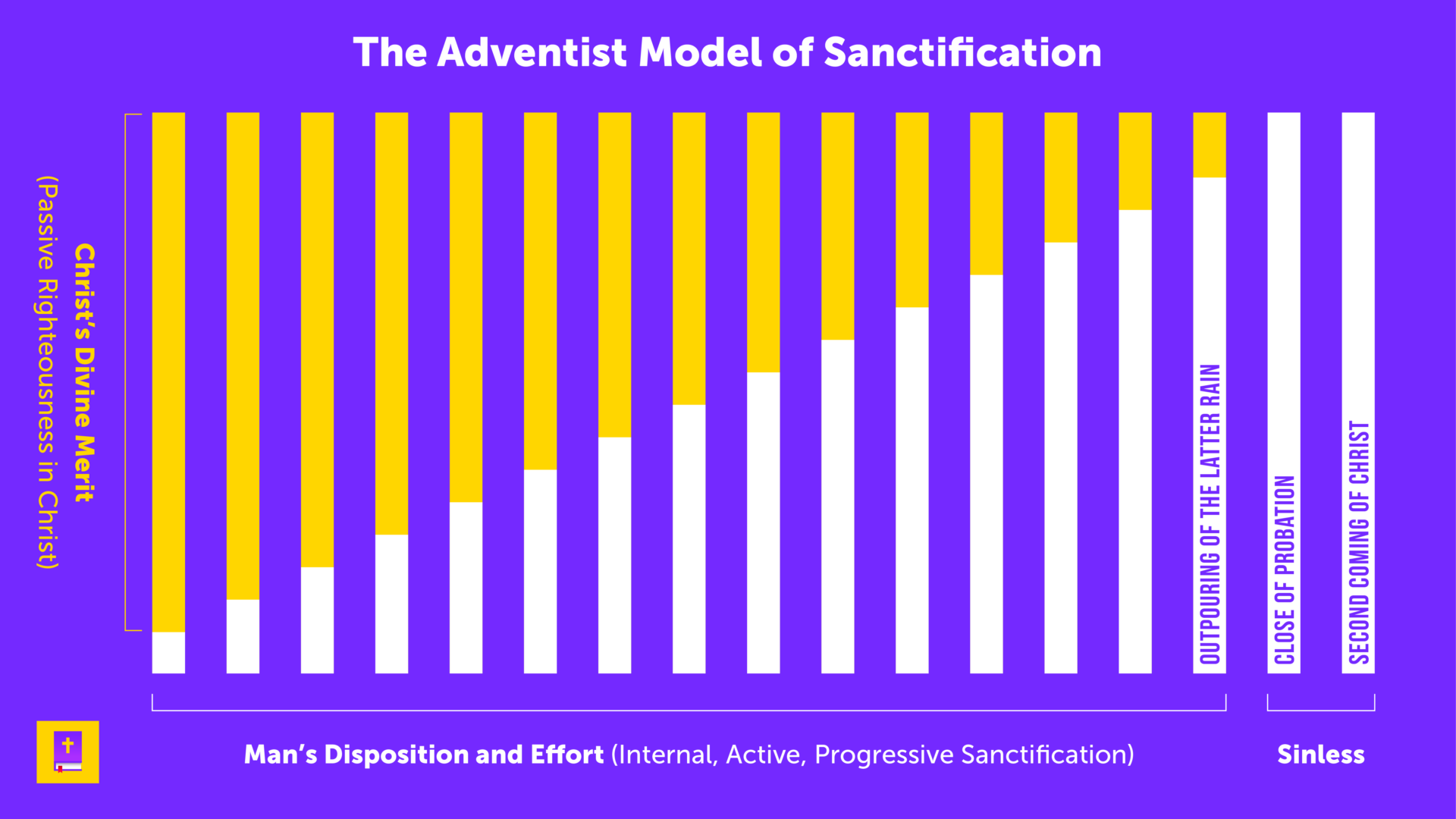Ever since the 1888 General Conference Session, the SDA Church has been more and more vocal regarding the term “righteousness by faith.” In an attempt to appear like just another Protestant denomination, they have latched onto this Reformation buzzphrase and muddied the waters because of it. It’s vitally important to realize that they do not mean what Protestants/Evangelicals do.
Ellen G. White, who the SDA Church believes was divinely inspired and corrects inaccurate interpretations of scripture, claimed that man is gradually imparted with the righteousness of Christ over the course of their life, such that they can meet the demands of the law and find acceptance with God. In other words, Christ’s righteousness is not imputed in full to the individual, but is imparted in small spurts in accordance with one’s cooperation and obedience to the 10 Commandments.
SDA historian George R. Knight, in his book A Search for Identity: The Development of Seventh-day Adventist Beliefs, he explains in part what the SDA Church puts forth in this area:
As a corrective [to the Reformers], Wesley emphasized sanctification as a process of becoming more like Jesus. To him, justification was the work of a moment while sanctification was the work of a lifetime. Justification came by imputed righteousness, sanctification by imparted righteousness.
George R. Knight, A Search for Identity: The Development of Seventh-day Adventist Beliefs, pg. 33
They appeal to John Wesley as the standard move on this subject. But John Wesley did not have a Great Controversy Worldview that defined everything for him like the SDA Church does. They believe in an initial justification followed by a progressive sanctification that, based on if you arrive at a totally perfected stated, will lead to a final or “eschatological justification.” And it’s this final justification that will determine if you are saved or not.
This is neither Protestant nor biblical. The irony of this is that this is precisely what the Roman Catholic Church teaches regarding infusion of righteousness to the believer over the course of their life, which keeps the individual in a state of grace, making them substantively righteous beings, leading to final justification. That is precisely the SDA model.
One is initially justified by grace through faith and then, over the course of their life, they are imparted with Christ’s righteousness gradually over time, based on their obedience to the 10 Commandments, which keeps them in a state of grace on the road to final justification.
This issue was a core, central aspect of the Reformation, yet the Adventist Church wants to claim they are Protestant and heirs of the Reformation when they are on the Roman Catholic side of this key issue (though, their views are not 100% identical).

In Adventist theology, your continued obedience isn’t merely the fruit of having been justified by God (declared righteous before Him). Ellen White taught that obedience maintains a person’s justification (righteous standing before God). And this happens by God gradually imparting to you Christ’s righteousness little by little, based on your obedience to the 10 Commandments, leading to a person eventually being sinlessly perfect. Which—in their system—is an absolute must before the “close of probation” and the Time of Trouble. One spot or stain upon the character will keep one from being saved.
The Bible does not teach a two-tier system of justification or that Christ’s righteousness is gradually impartated/infused to a person such that their obedience maintains their justification. This is putting the cart before the horse and mixing two distinct categories—justification and sanctification. Believers are imputed with Christ’s righteousness in full at the point of living faith in the Person and Work of Jesus (2 Corinthians 5:21). They are made a new creature in Christ (2 Corinthians 5:17) and receive all of the benefits of being united to Him—which includes Christ’s righteousness in full (Philippians 3:9-10). It is their faith alone, in Christ alone, that justifies them resulting in having complete peace with God (Romans 5:1). Paul doesn’t say believers are initially justified such that they have peace but that that can change based on the future. No, he says a person has peace with God and nothing can condemn them now (Romans 8:1).
It is after being justified, a person is moved to the next step (a separate category), and God then begins the work of sanctification within the individual which is where the fruit of being justified begins to manifest in the believers life. But the fruit (obedience) does not sustain the root (faith). It’s the other way around. The fruit is evidence of the root being present. The fruit and root are not the same.
God makes Christ sin (2 Corinthians 5:21) in the same manner that we become the righteousness of God—which is through imputation. This is built upon the bedrock of Isaiah 53, which has its foundation in the stipulations of the Levitical Day of Atonement (Leviticus 16). Christ bears our sin and we receive Christ’s righteousness. His perfect law-keeping is credited to the believer’s account. Paul utilizes this same language in Romans 4:3 when he quotes Genesis 15:6 in reference to Abraham, showing this isn’t unique to the New Testament believer. He summarily says in Romans 4:4-5 that justification comes, not to the one that works, which would make justification a wage or earning, but to the one that believes God by faith. It is that person’s faith that is credited as righteousness.
Before doing any act of obedience (circumcision, taking Issac up the mountain, etc.), Abraham was seen as righteous. God imputed Christ’s righteousness to Abraham in full. His walking out in obedience was a fruit of that happening, not something that maintained it for there to then be a second act of justification based on what Abraham did.
After appealing to Abraham, Paul also appeals to David as an example of this in Romans 4:6-7 where he quotes the Psalmist who said “‘Blessed are those whose lawless deeds are forgiven, and whose sins are covered; blessed is the man against whom the Lord will not count his sin.’” God “counts” righteousness to the sinner who looks to Christ by faith apart from works and doesn’t count their sin against them. This is the consistent teaching of the entire Bible.
When God imputes the righteousness of Christ to an individual, both the active and passive obedience of Christ are accounted to the persons record. These are simply two categories theologians have used to distinguish between what Christ did both actively in His perfect life (never sinned in thought, word, deed or motive) as well as His passive obedience of submission to the will of the Father (ie: going to the cross and dying willfully as the Suffering Servant). Both of these things were necessary for Christ to meet the requirements of the Law and to fulfill all righteousness.
Because Christ was both perfectly active and passively obedient, His perfect record can be imputed to us such that it is as if we lived the life He did. God’s standard is total perfection. Without Christ’s perfect righteousness imputed to us, we could have no hope. This is why the Reformers recognized—as scripture does—that salvation is by Christ alone (solus Christus). All of it. There is no obedience alongside Christ’s work that, as a joint effort, gets a person to the finish line. This is not to say that Christians do not obey God, but that obedience is in a different category all together.
The SDA Church has tried to denigrate the teaching of Christ’s active and passive obedience being imputed to the believer by claiming it’s “Calvinistic”—which is one of their favorite boogeymen to associate teachings they don’t like with (their pioneers loathed Reformed theology). They claim—like John Wesley who they love—that this belief leads to a person being complacent about sanctification. But instead of dismissing this idea by associating it with a group they don’t like (the genetic fallacy), what matters is what does the Bible teach?
They don’t understand that God is the one that not only declares a person justified (righteous), but also works sanctification in the person. He doesn’t do one and not the other. When God regenerates a person (Titus 3:5), they are actually a changed creature (2 Corinthians 5:17). God begins sanctifying all of those that He justifies because He is the author and finisher of the entire chain salvation—calling, electing, justifying, sanctifying, and glorifying (Hebrews 12:2; Romans 8:28-30). New desires come with being born again such that everyone who is born again has a changed heart and desires to seek God—something they could not previously do (Romans 3:9-11). It produces the exact opposite of complacency because God is in the drivers seat, not man.
This misunderstanding has led them to embrace a false view of justification and imputed righteousness such that their view goes back to the Medieval Roman view that the church was seeking to reform and correct in accordance with scripture. It is why many SDA’s are actually looking to themselves for salvation because it’s their continued obedience that is maintaining their righteous standing on the road to eventually making it (final justification). But this is not the good news—it is a false gospel (Galatians 1:6-9, 2 Corinthians 11:3-4). The good news is that Jesus paid it all and He alone is sufficient. You can trust in Him by faith for salvation, be given Christ’s righteousness in full, be freed from the curse of the Law (Galatians 3:13), have complete peace with God right now (Romans 5:1; 8:1), and be set free to do good works (Ephesians 2:8-10). Not to then maintain your righteous standing, but to live a life pleasing to God in gratitude for the gift of salvation and God remembering your sins no more—which is a promise of the New Covenant (Jeremiah 31:31-4; Hebrews 8:12).
The Bible teaches the full imputation of Christ’s righteousness to believers, not partial imparted or infused righteousness gradually over time in accordance with how well one cooperates.
Ellen White claimed that “whatever contradicts God’s Word, we can be sure proceeds from Satan”, that her writings never contradict God’s Word, and bear the test of investigation. We’ll let you connect the dots.










